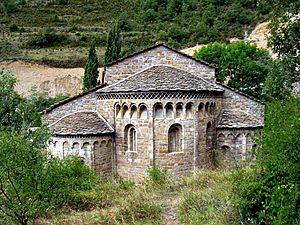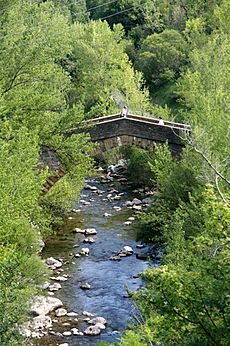William Isarn facts for kids
William Isarn (also known as Guillermo Isárnez) was a count who ruled a region called Ribagorza from 1010 until he died in 1017 or 1018. He was quite young when he became part of an important agreement to share power with his cousin and her husband. This agreement was supported by the powerful Count of Castile. William used an army from Castile to push out the Muslim groups who were controlling the valley of the Isábena River. Sadly, he was killed while trying to get back his family's land rights in the Val d'Aran before he could finish his work of taking back Christian lands, known as the Reconquista. His death caused a big problem over who would rule Ribagorza next. In the end, Ribagorza became part of the lands ruled by the King of Navarre.
Contents
William's Early Life and Becoming Count
William Isarn was the son of a count named Isarn Raymond. When he was a child, he lived with his grandmother, Garsenda of Fezensac. As he grew older, he was sent to live with his cousin, Sancho García of Castile, who was the Count of Castile. There, William learned how to be a warrior and a leader.
In 1003, William's father, Count Isarn, died while fighting against an invasion by a Muslim leader named Abd al-Malik al-Muzaffar. After Isarn's death, his sister, Toda, became the ruler of Ribagorza. In 1006, Abd al-Malik invaded Ribagorza again. This forced Countess Toda to marry Sunyer, who was the count of the nearby region of Pallars.
The growing power of Pallars over Ribagorza worried Toda's relatives in Castile. So, Countess Toda asked her nephew, Sancho of Castile, for military help to keep Ribagorza independent. Count Sancho sent his sister, Mayor García, who was married to Sunyer's oldest son, Raymond III. Toda then named Mayor as her heir and stepped down from her role as countess. Count Sancho also sent young William with a Castilian army. William was given a role in the government of Ribagorza.
William Isarn, along with Mayor and Raymond III, began ruling Ribagorza between March and August of 1010. William signed a document in March 1016, giving money to a monastery. In this document, he called himself "count, by the grace of God," which meant he believed he had the right to rule independently.
Taking Back Lands: The Reconquista
An old book from around 1154, called the Crónica de Alaón renovada, says that Count Sancho gave William "a great army." With this army, William worked to remove the Muslim groups who were controlling the valley of the Isábena River. He especially focused on taking back Roda, which was an important religious center.
However, the Crónica also says that William and his Castilian army could not free the "Great Valley" (Valle Magna), which was the lower part of the Ésera River. Still, William's efforts to bring back Christian rule to lands taken by the Muslims were very important. In a document from 1012, the monks of Santa María de Obarra wrote that it was "the second year of Count William happily reigning." William himself signed this document along with his close group of trusted lords and leaders.
William's Last Fight and Death
On November 24, 1017, William Isarn performed his last known official act. He and his important leaders witnessed the special ceremony where Borrell became the Bishop of Roda. William had approved Borrell's election just three days earlier.
Soon after, either in late 1017 or early 1018, William led a journey into the Val d'Aran. He likely went there to claim his family's rights to the land. Long ago, the lands of his great-great-grandfather, Raymond I, were divided. William's great-grandfather, Bernard Unifred, received Ribagorza, while Bernard's brother, Bishop Atto of Roda, received the Val d'Aran.
According to the Crónica de Alaón, William tried to reclaim the Val d'Aran, saying it belonged to his father, Isarn, and his grandfather, Raymond II, especially after Bishop Atto died. But the people living in the valley did not want him to take control. They killed him, saying among themselves, "This is the heir, come, let us kill him and his inheritance will remain with us."
William's death, and the death of his supporter Count Sancho of Castile shortly before him in February 1017, created a power gap in Ribagorza. This gap was quickly filled by King Sancho III of Pamplona, who had married Count Sancho of Castile's daughter, Muniadona.
See also
 In Spanish: Guillermo de Ribagorza para niños
In Spanish: Guillermo de Ribagorza para niños




